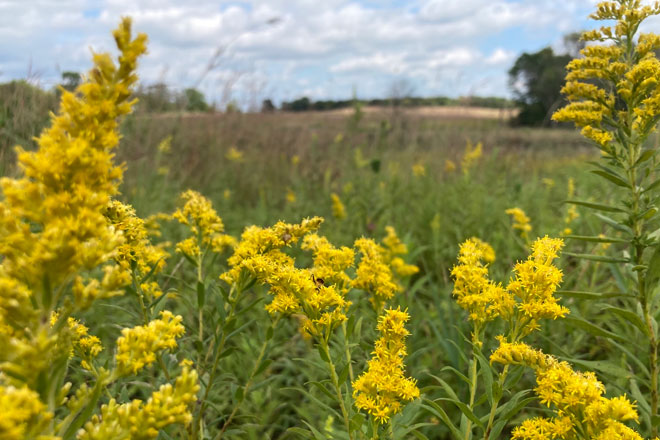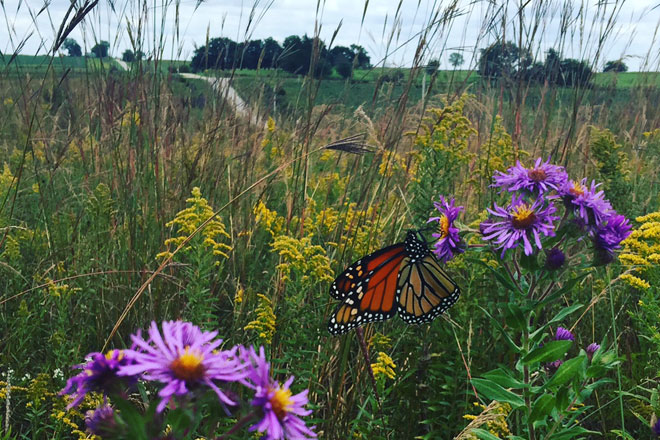Upland birds also appreciate variety in early fall
By Aaron Kuehl, Director of Habitat Programs
The importance of milkweed as a host plant for the monarch butterfly is well-documented and has been popularized over the past several years. Pheasants Forever biologists were early adopters of the importance of milkweed and have been including at least one species of milkweed in most of our seed mixes for a decade; impacting 28,500 projects, 290,000 acres, and more than 1 billion seeds.
Perhaps more encouraging is the change in public perception in recent years. Milkweed is being planted in gardens, farmers are mowing around milkweed patches in ditches, campus (public, corporate and university) landscape crews leave volunteer milkweeds undisturbed, and many grade school students have a monarch caterpillar or chrysalis in their classroom right now. We’re witnessing a cultural shift that gives hope for the future.
But the monarch needs more than milkweed and hope. Their population has declined by 85 percent since the mid-1990s. The winter population in 2021-22 was up slightly over the previous years, but still only half of the threshold scientists suggest for monarchs to be securely out of the danger zone for extinction.
Right now, millions of monarch butterflies from as far north as Canada have begun their fall migration stretching 3,000 miles to Mexico. It took three generations of butterflies to make the trek north, but a single generation (aka the “monarch super generation”) will make the return trip to a place never visited by their parents or grandparents. Each monarch will fly an estimated 50 miles per day, requiring significant replenishment of energy reserves.
Data shows that monarch population declines start to occur each fall in association with migration. Researchers at Cornell University suggest this may indicate milkweed is not the limiting factor (or certainly not the only one) during this period, but rather the availability of nectar during their iconic trek. Milkweed served its purpose for monarch reproduction and food during the summer months, but what’s available during the fall migration? ANSWER: the late-blooming nectar powerhouse triad of goldenrod, aster, and blazing star.
 Goldenrod
Goldenrod
The exploding yellow “ka-blooms” of goldenrod are hard to miss this time of year. These nutritious nectar nodes are sometimes unfairly blamed for seasonal allergies due to their high visibility and co-emergence with the real hay-fever culprit, ragweed (which, by the way, provides a great seed source to upland birds and songbirds). Where ragweed pollen is light and floats freely on the breeze right into your nose, goldenrod pollen is too heavy for unassisted airborne travel, but serves as a delicious energy source for pollinators like monarchs. There are dozens of species of native goldenrod in North America. Those commonly used as preferred monarch forage include Canada goldenrod (Solidago canadensis; can be aggressive), grass-leaved (Euthamia graminifolia), Missouri (Solidago missouriensis), old-field (Solidago nemoralis), showy (Solidago speciosa), stiff (Oligoneuron rigidum), and zig-zag (Solidago flexicaulis) goldenrod.
Asters (Symphoytrichum spp) are another late-blooming (August – October) species providing a preferred nectar source for monarchs. Their showy purplish-bluish-pinkish blossoms provide a sharp contrast to the “golden” rods. New England aster (S. novae-angliae) is the most popular among planted species, tolerates a wide variety of soils and may be the best all-purpose aster for monarchs. Smooth blue aster (S. leave) and sky-blue aster (S. oolentangiense) are similar varieties but with less tolerance for wet feet. Aromatic aster (S. oblongifolium) has a bloom period stretching into November providing that last minute nectar source during migration. Heath aster (S. ericoides) is a common white beneficial aster that can become aggressive.
 Aster
Aster
The final leg of the late-blooming (July – October) nectar stool are the blazing stars (Liatris spp). Featured in the lead image, these blooms are spiked with tall, fiery purple-pink flowers. Commonly seeded blazing star species include marsh (L aspera), dense (L spicata), prairie (L pycnostachya), dotted (L punctata) and meadow (L ligulistylis) blazing star.
Because to the variety of species available in goldenrods, asters and blazing stars, land managers can find a particular species (or several) of each that are appropriate for the region, soil conditions and sun exposure for their project. The triad certainly represent the monarch fan-favorites, but several additional late-blooming species can be considered when setting up your buffet for migrating monarchs including sunflowers (annual, maximilian, oxeye, sawtooth), ironweeds (common, giant), boneset (common, false), vervain (blue, hoary), leadplant, and spotted Joe Pye weed.
As some upland bird hunters can attest to, all the late-blooming species attract and hold pollinating insects, grasshoppers, and other food which pheasant broods find highly attractive during the early fall…and even into the upland seasons!
Pheasants Forever biologists are keeping the iconic orange and black butterfly trekking across North America each fall when designing our seed mixes (available at
PFHabitatStore.com), and we encourage you to do the same. Think Habitat!